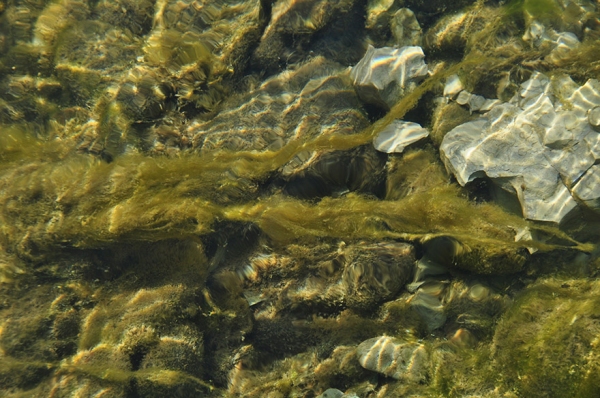In shallow, East Coast, streams algae and bacteria growing on the cobble bed (collectively called ‘periphyton’) often reach ‘nuisance’ levels during summer low flows.
Periphyton biomass accumulates because high temperature and sunlight and sufficient nutrients promote rapid growth, low flows do not ‘scour’ biomass from the cobbles, and high temperatures reduce grazing by aquatic insects. Periphyton growth, biomass accrual and nutrient removal from the water occur at high rates where there are inputs of nitrogen and phosphorus. However, nutrient uptake into growing periphyton means that soluble nutrient concentrations decline with distance downstream unless there are nutrient inflows along the river or nutrients are ‘recycled’ rapidly from dead and decaying biomass. This is predicted to limit the downstream extent of periphyton blooms as nutrients drop below levels that stimulate rapid growth. Instream uptake of nutrients also influences the amount, timing and form (i.e. dissolved inorganic vs organic vs particulate) of nutrients reaching downstream environments, such as lakes, estuaries and the coast. It is important to understand how quickly nutrients are removed and recycled in order to set limits on nutrient losses from land and point sources to maintain ecosystem health.
The Tukituki River has been the focus of nutrient and periphyton studies led by NIWA in collaboration with Cawthron, AgResearch, GNS-Science and Hawke’s Bay Regional Council since 2011. It is an ideal study location because near the townships of Waipukurau and Waipawa there are inflows of nitrogen in upwelling groundwater from the Ruataniwha Plains together with inflows of phosphorus from wastewater treatment plants. For 70 km below Waipukurau/Waipawa there are no significant inflows during summer low flows, which makes it easier to study uptake and recycling.
During summer low flows, soluble nitrogen concentrations are high near Waipukurau but decrease to below the limit of detection near the sea. Soluble phosphorus concentrations also decrease but remain well above detection limits near the sea.
Why is all the soluble nitrogen removed from the water but not all the phosphorus? Either there is a nitrogen sink in addition to periphyton uptake or there is a source of soluble phosphorus in the lower part of the river. Denitrification was measured during low flows in 2011 and cannot explain the disappearance of nitrogen. In 2015 and 2016 phosphorus release from stream bed sediments was investigated. Measurements were made of the amount of phosphorus adsorbed onto sediment at different values of pH. It was found in the laboratory that, at high pH, phosphorus desorbs from the sediments. It was found in the river that pH was high in the afternoons (above 9) as a result of periphyton photosynthesis, likely resulting in the release of soluble phosphorus from the bed sediments.
These studies show that sediments are currently a source of phosphorus during summer low flows which probably contributes to ‘nuisance’ levels of periphyton biomass. It is not clear, however, whether sediment phosphorus originates principally from the wastewater treatment plants or from farming and forestry in the catchment. In 2015 phosphorus inputs from the wastewater treatment plants were reduced which is expected to result in lower sediment phosphorus stores. However, our 2016 studies did not detect any significant reduction in periphyton abundance and it may take some years for ‘legacy’ sediment phosphorus to disappear. Surveys planned for 2017 will further address the legacy sediment phosphorus issue. If sediment phosphorus derives principally from the catchment then the focus will need to be on reducing input of P-rich sediment from catchment sources.
Collaborators
Dr Bob Wilcock (NIWA), Dr John Quinn (NIWA), Brian Smith (NIWA), Dr Roger Young (Cawthron) and Prof Richard McDowell (AgResearch), Prof Sherry Schiff (University of Waterloo, Canada), Prof Mike English (Wilfred Laurier University, Canada), Dr Troy Baisden (GNS), Dr Andy Hicks (Hawkes Bay Regional Council).



